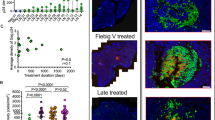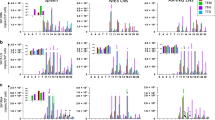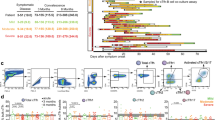Abstract
Chronic-phase HIV and simian immunodeficiency virus (SIV) replication is reduced by as much as 10,000-fold in elite controllers (ECs) compared with typical progressors (TPs), but sufficient viral replication persists in EC tissues to allow viral sequence evolution and induce excess immune activation. Here we show that productive SIV infection in rhesus monkey ECs, but not TPs, is markedly restricted to CD4+ follicular helper T (TFH) cells, suggesting that these EC monkeys' highly effective SIV-specific CD8+ T cells can effectively clear productive SIV infection from extrafollicular sites, but their relative exclusion from B cell follicles prevents their elimination of productively infected TFH cells. CD8+ lymphocyte depletion in EC monkeys resulted in a dramatic re-distribution of productive SIV infection to non-TFH cells, with restriction of productive infection to TFH cells resuming upon CD8+ T cell recovery. Thus, B cell follicles constitute 'sanctuaries' for persistent SIV replication in the presence of potent anti-viral CD8+ T cell responses, potentially complicating efforts to cure HIV infection with therapeutic vaccination or T cell immunotherapy.
This is a preview of subscription content, access via your institution
Access options
Subscribe to this journal
Receive 12 print issues and online access
$209.00 per year
only $17.42 per issue
Buy this article
- Purchase on Springer Link
- Instant access to full article PDF
Prices may be subject to local taxes which are calculated during checkout






Similar content being viewed by others
References
Kirchhoff, F. Immune evasion and counteraction of restriction factors by HIV-1 and other primate lentiviruses. Cell Host Microbe 8, 55–67 (2010).
Picker, L.J., Hansen, S.G. & Lifson, J.D. New paradigms for HIV/AIDS vaccine development. Annu. Rev. Med. 63, 95–111 (2012).
Okoye, A.A. & Picker, L.J. CD4+ T cell depletion in HIV infection: mechanisms of immunological failure. Immunol. Rev. 254, 54–64 (2013).
Deeks, S.G. & Walker, B.D. Human immunodeficiency virus controllers: mechanisms of durable virus control in the absence of antiretroviral therapy. Immunity 27, 406–416 (2007).
Mudd, P.A. & Watkins, D.I. Understanding animal models of elite control: windows on effective immune responses against immunodeficiency viruses. Curr. Opin. HIV AIDS 6, 197–201 (2011).
Katlama, C. et al. Barriers to a cure for HIV: new ways to target and eradicate HIV-1 reservoirs. Lancet 381, 2109–2117 (2013).
Hatano, H. et al. Evidence for persistent low-level viremia in individuals who control human immunodeficiency virus in the absence of antiretroviral therapy. J. Virol. 83, 329–335 (2009).
Pereyra, F. et al. Persistent low-level viremia in HIV-1 elite controllers and relationship to immunologic parameters. J. Infect. Dis. 200, 984–990 (2009).
Chun, T.W. et al. Effect of antiretroviral therapy on HIV reservoirs in elite controllers. J. Infect. Dis. 208, 1443–1447 (2013).
Bailey, J.R., Williams, T.M., Siliciano, R.F. & Blankson, J.N. Maintenance of viral suppression in HIV-1-infected HLA-B*57+ elite suppressors despite CTL escape mutations. J. Exp. Med. 203, 1357–1369 (2006).
Mens, H. et al. HIV-1 continues to replicate and evolve in patients with natural control of HIV infection. J. Virol. 84, 12971–12981 (2010).
O'Connell, K.A. et al. Control of HIV-1 in elite suppressors despite ongoing replication and evolution in plasma virus. J. Virol. 84, 7018–7028 (2010).
Hunt, P.W. et al. Relationship between T cell activation and CD4+ T cell count in HIV-seropositive individuals with undetectable plasma HIV RNA levels in the absence of therapy. J. Infect. Dis. 197, 126–133 (2008).
Hatano, H. et al. Prospective antiretroviral treatment of asymptomatic, HIV-1 infected controllers. PLoS Pathog. 9, e1003691 (2013).
Walker, B.D. & Yu, X.G. Unravelling the mechanisms of durable control of HIV-1. Nat. Rev. Immunol. 13, 487–498 (2013).
Sáez-Cirión, A. & Pancino, G. HIV controllers: a genetically determined or inducible phenotype? Immunol. Rev. 254, 281–294 (2013).
Mendoza, D. et al. Cytotoxic capacity of SIV-specific CD8+ T cells against primary autologous targets correlates with immune control in SIV-infected rhesus macaques. PLoS Pathog. 9, e1003195 (2013).
Mudd, P.A. et al. Reduction of CD4+ T cells in vivo does not affect virus load in macaque elite controllers. J. Virol. 85, 7454–7459 (2011).
Friedrich, T.C. et al. Subdominant CD8+ T cell responses are involved in durable control of AIDS virus replication. J. Virol. 81, 3465–3476 (2007).
Blankson, J.N. et al. Isolation and characterization of replication-competent human immunodeficiency virus type 1 from a subset of elite suppressors. J. Virol. 81, 2508–2518 (2007).
Fukazawa, Y. et al. Lymph node T cell responses predict the efficacy of live attenuated SIV vaccines. Nat. Med. 18, 1673–1681 (2012).
Crotty, S. Follicular helper CD4 T cells (TFH). Annu. Rev. Immunol. 29, 621–663 (2011).
Vinuesa, C.G. & Cyster, J.G. How T cells earn the follicular rite of passage. Immunity 35, 671–680 (2011).
Connick, E. et al. CTL fail to accumulate at sites of HIV-1 replication in lymphoid tissue. J. Immunol. 178, 6975–6983 (2007).
Tjernlund, A. et al. In situ detection of Gag-specific CD8+ cells in the GI tract of SIV infected Rhesus macaques. Retrovirology 7, 1–14 (2010).
Sasikala-Appukuttan, A.K. et al. Location and dynamics of the immunodominant CD8 T cell response to SIVnef immunization and SIVmac251 vaginal challenge. PLoS ONE 8, e81623 (2013).
Robinson, H.L. & Amara, R.R. Protective immunity from a germinal center sanctuary. Nat. Med. 18, 1614–1616 (2012).
Skinner, P.J. & Connick, E. Overcoming the immune privilege of B cell follicles to cure HIV-1 infection. J. Hum. Virol. Retrovirol. 1, 00001–00003. jhvrv.2014.01.00001 (2014).
Perreau, M. et al. Follicular helper T cells serve as the major CD4 T cell compartment for HIV-1 infection, replication, and production. J. Exp. Med. 210, 143–156 (2013).
Lindqvist, M. et al. Expansion of HIV-specific T follicular helper cells in chronic HIV infection. J. Clin. Invest. 122, 3271–3280 (2012).
Brenchley, J.M. et al. Differential infection patterns of CD4+ T cells and lymphoid tissue viral burden distinguish progressive and nonprogressive lentiviral infections. Blood 120, 4172–4181 (2012).
Petrovas, C. et al. CD4 T follicular helper cell dynamics during SIV infection. J. Clin. Invest. 122, 3281–3294 (2012).
Klatt, N.R. et al. SIV infection of rhesus macaques results in dysfunctional T and B cell responses to neo and recall Leishmania major vaccination. Blood 118, 5803–5812 (2011).
Chtanova, T. et al. T follicular helper cells express a distinctive transcriptional profile, reflecting their role as non-Th1/Th2 effector cells that provide help for B cells. J. Immunol. 173, 68–78 (2004).
Estes, J.D. Pathobiology of HIV/SIV-associated changes in secondary lymphoid tissues. Immunol. Rev. 254, 65–77 (2013).
Okoye, A. et al. Profound CD4+/CCR5+ T cell expansion is induced by CD8+ lymphocyte depletion but does not account for accelerated SIV pathogenesis. J. Exp. Med. 206, 1575–1588 (2009).
Leone, A. et al. Increased CD4+ T cell levels during IL-7 administration of antiretroviral therapy-treated simian immunodeficiency virus-positive macaques are not dependent on strong proliferative responses. J. Immunol. 185, 1650–1659 (2010).
Quigley, M.F., Gonzalez, V.D., Granath, A., Andersson, J. & Sandberg, J.K. CXCR5+ CCR7− CD8 T cells are early effector memory cells that infiltrate tonsil B cell follicles. Eur. J. Immunol. 37, 3352–3362 (2007).
Wood, G.S., Garcia, C.F., Dorfman, R.F. & Warnke, R.A. The immunohistology of follicle lysis in lymph node biopsies from homosexual men. Blood 66, 1092–1097 (1985).
Tenner-Rácz, K. et al. Monoclonal antibodies to human immunodeficiency virus: their relation to the patterns of lymph node changes in persistent generalized lymphadenopathy and AIDS. AIDS 1, 95–104 (1987).
Tenner-Racz, K. et al. Cytotoxic effector cell granules recognized by the monoclonal antibody TIA-1 are present in CD8+ lymphocytes in lymph nodes of human immunodeficiency virus-1-infected patients. Am. J. Pathol. 142, 1750–1758 (1993).
Petrovas, C. et al. A population of CD8+ T cells located in germinal centers that is functionally capable of mediating bispecific antibody killing of HIV-infected T cells. 20th International AIDS Conference Melbourne, Australia, http://pag.aids2014.org/Abstracts.aspx?SID=1147&AID=5387 (2014).
Shan, L. et al. Stimulation of HIV-1-specific cytolytic T lymphocytes facilitates elimination of latent viral reservoir after virus reactivation. Immunity 36, 491–501 (2012).
Anolik, J.H. & Aringer, M. New treatments for SLE: cell-depleting and anti-cytokine therapies. Best Pract. Res. Clin. Rheumatol. 19, 859–878 (2005).
Hansen, S.G. et al. Immune clearance of highly pathogenic SIV infection. Nature 502, 100–104 (2013).
Cline, A.N., Bess, J.W., Piatak, M. Jr. & Lifson, J.D. Highly sensitive SIV plasma viral load assay: practical considerations, realistic performance expectations, and application to reverse engineering of vaccines for AIDS. J. Med. Primatol. 34, 303–312 (2005).
Venneti, S. et al. Longitudinal in vivo positron emission tomography imaging of infected and activated brain macrophages in a macaque model of human immunodeficiency virus encephalitis correlates with central and peripheral markers of encephalitis and areas of synaptic degeneration. Am. J. Pathol. 172, 1603–1616 (2008).
Brown, C.R. et al. Unique pathology in simian immunodeficiency virus-infected rapid progressor macaques is consistent with a pathogenesis distinct from that of classical AIDS. J. Virol. 81, 5594–5606 (2007).
Smedley, J. et al. Tracking the luminal exposure and lymphatic drainage pathways of intravaginal and intrarectal inocula used in nonhuman primate models of HIV transmission. PLoS ONE 9, e92830 (2014).
Wolfe, M.H.D.A. Nonparametric Statistical Methods (John Wiley & Sons, New York, 1999).
R Core Team. R: a language and environment for statistical computing. (http://www.r-project.org/) (R Foundation for Statistical Computing, Vienna, Austria, 2014).
Acknowledgements
The authors dedicate this paper to the memory of Michael Piatak, Jr., in recognition of his key enabling contributions to this study and so many others. This work was supported by the US National Institutes of Health; grants 5R37A1054292 (L.J.P.), 5U19AI096109 (L.J.P. and A.A.O.), and 8P51OD01109255, contract HHSN261200800001E (R.S., M.P., J.D.E. and J.D.L.) and Intramural Program of the US National Institute of Allergy and Infectious Diseases, and the Bill and Melinda Gates Foundation (grant no. 41185; L.J.P.). The authors thank R. Wiseman and D. Watkins for MHC typing; Dr. K. Reimann and the US National Institutes of Health Nonhuman Primate Reagent Resource Program for provision of the CD8α-specific monoclonal antibody M-T807R1; D. Hazuda (Merck Research Labs) for providing cART drugs for cohort 1; Cytheris SA (Issy Les Moulineaux, France) for recombinant rhesus IL-7; S. Hansen for animal study management; A. Sylwester, L. Koo, J. Clock, A. Konfe, H.W. Kim, M. Rohankhedkar, M. Reyes, N. Coombes, B. Assaf, K. Oswald, R. Fast, Y. Li, C. Trubey, J. Turner, S. Planer and L. Boshears for technical or administrative assistance.
Author information
Authors and Affiliations
Contributions
L.J.P. and Y.F. conceived the study, designed the experiments and wrote the paper, assisted by A.A.O., H.P. and J.D.L. Y.F. also supervised the experiments, performed immunologic and SIV coculture assays, and analyzed the data, assisted by R.L., J.Y.B. and S.I.H. A.W.L. and M.K.A. managed the animal protocols, assisted by T.S. K.M., V.M.H., C.D., C.L., D.M. and J.D.E. provided tissue-based analysis including immunohistochemistry and RNAscope. M.P., Jr. and J.D.L. planned and performed SIV quantification, assisted by R.S. J.H. and R.G. developed and provided optimized cART regimens (cohort 2). P.T.E. performed the statistical analysis of study data.
Corresponding author
Ethics declarations
Competing interests
The authors declare no competing financial interests.
Supplementary information
Supplementary Text and Figures
Combined Supplementary Figures 1–9 and Supplementary Tables 1–2. (PDF 31015 kb)
Rights and permissions
About this article
Cite this article
Fukazawa, Y., Lum, R., Okoye, A. et al. B cell follicle sanctuary permits persistent productive simian immunodeficiency virus infection in elite controllers. Nat Med 21, 132–139 (2015). https://doi.org/10.1038/nm.3781
Received:
Accepted:
Published:
Issue Date:
DOI: https://doi.org/10.1038/nm.3781
This article is cited by
-
Prevention, treatment and cure of HIV infection
Nature Reviews Microbiology (2023)
-
CD8 lymphocytes mitigate HIV-1 persistence in lymph node follicular helper T cells during hyperacute-treated infection
Nature Communications (2022)
-
HIV cure strategies: which ones are appropriate for Africa?
Cellular and Molecular Life Sciences (2022)
-
Systematic post-mortem analysis of brain tissue from an HIV-1 subtype C viremic decedent revealed a paucity of infection and pathology
Journal of NeuroVirology (2022)
-
Limited impact of fingolimod treatment during the initial weeks of ART in SIV-infected rhesus macaques
Nature Communications (2022)



